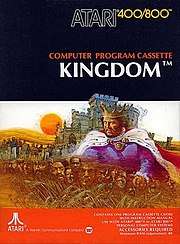Atari 8-bit family software

This article is an overview of programs available for the Atari 8-bit family of home computers (the 400/800, XL, and XE series). Software was sold both by Atari, Inc. (later Atari Corporation) and third parties. Atari also distributed software through the Atari Program Exchange from 1981-1984, then many APX titles were picked up by Antic Software.
Programming languages
Assembly language
Atari, Inc. published two assemblers. The Atari Assembler Editor cartridge is a friendlier, integrated development environment on using line numbers for editing source code similar to Atari BASIC. The professionally-targeted Atari Macro Assembler shipped at a higher price and came on a copy protected disk without editor or debugger. A number of third party assemblers also exist, including SynAssembler from Synapse Software and MAE (Macro Assembler Editor) from Eastern House.
Optimized Systems Software published an enhanced disk-based assembler mimicking the structure of Atari's Assembler Editor as EASMD (Editor/Assembler/Debug). It followed that with MAC/65 (first on disk, then as a 16KB bank-switched cartridge) that tokenizes lines of code as they are entered and has much faster assembly times than Atari's products.
Dunion's Debugging Tool (or DDT) by Jim Dunion is a machine language debugger originally sold through the Atari Program Exchange. A simplified version was included in the cartridge version of MAC/65.
BASIC
Atari shipped Atari BASIC with all their machines either as a cartridge or in ROM. It also sold Atari Microsoft BASIC on disk. Optimized Systems Software created a series of enhanced BASICs: BASIC A+, BASIC XL, BASIC XE. Advan BASIC and Turbo BASIC XL , both from 1985, are compilers that generate machine code.
Pascal
Atari's own Atari Pascal requires two disk drives and was relegated to the Atari Program Exchange instead of Atari's official product line. Later options were Draper Pascal and Kyan Pascal.
Forth
Atari 8-bit Forths include fig-Forth, Extended fig-Forth (Atari Program Exchange), ES-Forth, QS Forth, and ValFORTH.
Other
Action! is an ALGOL 68-like procedural programming language that shipped on cartridge with an integrated compiler and full-screen text editor. The language is designed for quick compile times and to generate efficient 6502 machine code.
Deep Blue C is a port of Ron Cain's Small-C compiler. It was sold through the Atari Program Exchange.
Atari, Inc. published versions of Atari Logo and Atari PILOT on cartridge.
Other Atari 8-bit family languages include INTER-LISP/65 and WSFN.
Applications
- See Category:Atari 8-bit family software.
Word processors
Atari, Inc. published the Atari Word Processor in 1981, followed by the more popular AtariWriter cartridge in 1983. Third party options include PaperClip, Letter Perfect, Word Magic, Superscript, Bank Street Writer, COMPUTE! magazine's type-in SpeedScript, The Writer's Tool,[1] Muse Software's Super-Text,[2] and relative latecomer The First XLEnt Word Processor in 1986. Cut & Paste from Electronic Arts and Homeword from Sierra On-Line[2] were designed to be simpler to use than other programs.
Two integrated software packages that include word processing are HomePak and Mini Office II. Antic compared seven word processors in the February 1987 issue of the magazine.[3]
Games
- See Category:Atari 8-bit family games.
Because of graphics superior to that of the Apple II[4] and Atari's home-oriented marketing,[5] the Atari 8-bit computers gained a good reputation for games. BYTE in 1981 stated that "for sound and video graphics [they] are hard to beat".[6] Jerry Pournelle wrote in the magazine in 1982, when trying to decide what computer to buy his sons, that "if you're only interested in games, that's the machine to get. It's not all that expensive, either".[4] Games dominated the Atari software library and there were fewer business applications than for the Apple II. A 1984 compendium of reviews used 198 pages for games compared to 167 for all others. It noted the existence of a distinct "graphics look" to native Atari software: "Multiple graphics modes, four directional fine scrolling, colorful modified character-set backgrounds, and, of course, player missile graphics."[5]
Star Raiders was Atari's killer app, akin to VisiCalc for the Apple II in its ability to persuade customers to buy the computer.[7] Antic in 1986 stated that "it was the first program that showed all of the Atari computer's audio and visual capabilities. It was just a game, yes, but it revolutionized the idea of what a personal computer could be made to do."[8]
References
- ↑ "The Writer's Tool". Atari Mania.
- 1 2 Curtin, Bob (March 1985). "A Word Processing Trilogy". ANALOG Computing (28): 57–64.
- ↑ Pearlman, Gregg (February 1987). "Word Processors: 7 For The 8-Bit". Antic. 5 (10).
- 1 2 Pournelle, Jerry (July 1982). "Computers for Humanity". BYTE. p. 392. Retrieved 19 October 2013.
- 1 2 Stanton, Jeffrey; Wells, Robert P.; Rochowansky, Sandra; Mellid, Michael, eds. (1984). The Addison-Wesley Book of Atari Software. Addison-Wesley. pp. TOC, 12, 210. ISBN 0-201-16454-X.
- ↑ Williams, Gregg (December 1981). "New Games New Directions". BYTE. pp. 6–10. Retrieved 19 October 2016.
- ↑ Williams, Gregg (May 1981). "Star Raiders". BYTE. p. 106. Retrieved 18 October 2013.
- ↑ Bisson, Gigi (May 1986). "Antic Then & Now". Antic. 5 (1). pp. 16–23. Retrieved 28 January 2015.